Fungal diversity and occurrence of mycotoxin producing fungi in tropical vineyards.
Fungal diversity and occurrence of mycotoxin producing fungi in tropical vineyards.
Autoria: SILVA, L. D.; PEREIRA, G. E.; BATISTA, L. R.; MATTEOLI, F. P.
Resumo: Grapevine cultivars are distributed worldwide, nevertheless the fermentation of its grape berries renders distinct wine products that are highly associated to the local fungal community. Despite the symbiotic association between wine and the fungal metabolism, impacting both the terroir and mycotoxin production, few studies have explored the vineyard ecosystem fungal community using both molecular marker sequencing and mycotoxin production assessment. In this study, we investigated the fungal community of three grapevine cultivars (Vitis vinifera L.) in two tropical vineyards. Illumina MiSeq sequencing was performed on two biocompartments: grape berries (GB) and grapevine soil (GS); yielding a total of 578,495 fungal internal transcribed spacer 1 reads, which were used for taxonomic classification. GB and GS fungal communities were mainly constituted by Ascomycota phylum. GS harbors a significant richer and more diverse fungal community than GB. Among GB samples, Syrah grape berries exclusively shared fungal community included wine-associated yeasts (e.g. Saccharomycopsis vini) that may play key roles in wine terroir. Mycotoxin production assessment revealed the high potential of Aspergillus section Flavi and Penicillium section Citrina isolates to produce aflatoxin B1-B2 and citrinin, respectively. This is the first study to employ next-generation sequencing to investigate vineyard associated fungal community in Brazil. Our findings provide valuable insights on the available tools for fungal ecology assessment applied to food products emphasizing the coexistence between classical and molecular tools.
Ano de publicação: 2021
Tipo de publicação: Artigo de periódico
Unidade: Embrapa Uva e Vinho
Palavras-chave: Fungal ecology, Next-generation sequencing, Terroir, Tropical vineyard, Wine
Observações
1 - Por padrão são exibidas publicações dos últimos 20 anos. Para encontrar publicações mais antigas, configure o filtro ano de publicação, colocando o ano a partir do qual você deseja encontrar publicações. O filtro está na coluna da esquerda na busca acima.
2 - Para ler algumas publicações da Embrapa (apenas as que estão em formato ePub), é necessário ter, no celular ou computador, um desses softwares gratuitos. Sistemas Android: Google Play Livros; IOS: iBooks; Windows e Linux: software Calibre.
Acesse outras publicações
Acesse a Base de Dados da Pesquisa Agropecuária (BDPA) para consultar o acervo completo das bibliotecas da Embrapa.

